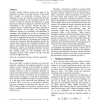Free Online Productivity Tools
i2Speak
i2Symbol
i2OCR
iTex2Img
iWeb2Print
iWeb2Shot
i2Type
iPdf2Split
iPdf2Merge
i2Bopomofo
i2Arabic
i2Style
i2Image
i2PDF
iLatex2Rtf
Sci2ools
AUSDM
2008
Springer
2008
Springer
On Inconsistencies in Quantifying Strength of Community Structures
Complex network analysis involves the study of the properties of various real world networks. In this broad field, research on community structures forms an important sub area. The strength of community structure is typically quantified by the modularity measure. The measure is based on summing the differences in actual and expected fraction of edges per community (across all communities in the network), whereby the latter is computed based on randomizing the edges subjected to certain constrains. In this paper, we investigate the differences between two commonly used definitions of modularity and highlight one of them as inadequate for quantifying the strength of community structures. We first show this by mathematical proving. We then investigate the empirical differences by developing and testing two variants of a community detection algorithm whereby the variants differ based on their modularity definitions. We observe varying differences in detection accuracy when applying the va...
| Added | 12 Oct 2010 |
| Updated | 12 Oct 2010 |
| Type | Conference |
| Year | 2008 |
| Where | AUSDM |
| Authors | Wen Haw Chong |
Comments (0)

